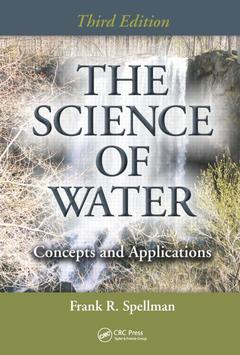The Science of Water (3rd Ed.) Concepts and Applications
Auteur : Spellman Frank R.

The Science of Water: Concepts and Applications, Third Edition contains a wealth of scientific information and is based on real-world experience. Building on the second edition, this text applies the latest data and research in the field, and addresses water contamination as a growing problem. The book material covers a wide range of water contaminants, the cause of these contaminants, and considers their impact on surface water and groundwater sources. It highlights the three distinct and separate sources of freshwater: surface water, groundwater, and groundwater under the direct influence of surface water (GUDISW). It discusses the conditions that constitute GUDISW and the Surface Water Treatment Rule (SWTR). It also explores sustainability and the effect of human use, misuse, and reuse of freshwater and wastewater on the overall water supply. Designed to fill a gap in the available material about water, the book examines water reserve utilization and the role of policymakers involved in the decision-making process. The book provides practical knowledge that practitioners and operators must have in order to pass licensure/certification tests and keep up with relevant changes. It also updates all previous chapters, presents numerous example math problems, and provides information not covered in earlier editions.
The Third Edition: Includes a new chapter on water economics, as well as a new chapter on water usage. Expands the coverage of wastewater stabilization ponds. Adds new problems, tables, and figures throughout. The Science of Water: Concepts and Applications, Third Edition serves a varied audience—it can be utilized by water/wastewater practitioners, as well as students, lay personnel, regulators, technical experts, attorneys, business leaders, and concerned citizens.
Introduction
Still Water
Setting the Stage
Historical Perspective
Thought-Provoking Questions
References and Recommended Reading
All about Water
How Special, Strange, and Different Is Water?
Characteristics of Water
Somewhere between 0° and 105°
Physical Properties of Water
Capillary Action
Water Cycle
Specific Water Movements
Q and Q Factors
Sources of Water
Watershed Protection
Potable Water
Key Definitions
Surface Water
Groundwater
Well Systems
Water Use
Water Content of Crops, Goods, Beverages, Animals, and Industrial Products
Thought-Provoking Question
References and Recommended Reading
Water Hydraulics
Terminology
What Is Water Hydraulics?
Water Balance
Basic Concepts
Density and Specific Gravity
Effects of Water under Pressure
Head
Flow/Discharge Rate: Water in Motion
Piezometric Surface and Bernoulli’s Theorem
Hydraulic Machines (Pumps)
Friction Head Loss
Basic Pumping Hydraulics
Open-Channel Flow
Flow Measurement
Thought-Provoking Questions
References and Recommended Reading
Water Chemistry
Chemistry Concepts and Definitions
Chemistry Fundamentals
Water Solutions
Water Constituents
Optical Phenomena: Water and Light
Common Water Measurements
Water Treatment Chemicals
Chemical Drinking Water Parameters
Thought-Provoking Question
References and Recommended Reading
Water Biology
Biology and Microbiology: What Are They?
Water Microorganisms
Cells
Bacteria
Protozoa
Microscopic Crustaceans
Viruses
Algae
Fungi
Microbiological Processes
Thought-Provoking Questions
References and Recommended Reading
Water Ecology
Setting the Stage
Levels of Organization
Ecosystems
Biogeochemical Cycles
Energy Flow in the Ecosystem
Food Chain Efficiency
Productivity
Population Ecology
Stream Genesis and Structure
An Overview of Benthic Life
Benthic Macroinvertebrates
Insect Macroinvertebrates
Non-Insect Macroinvertebrates
Thought-Provoking Questions
References and Recommended Reading
Water Pollution
Sources of Contaminants
Radionuclides
Chemical Cocktail
Groundwater Contamination
Self-Purification of Streams
Concentrated Animal Feeding Operations
Water Supply, Use, and Wastewater Treatment
Thought-Provoking Question
References and Recommended Reading
Environmental Biomonitoring, Sampling, and Testing
What Is Biomonitoring?
Biotic Index in Streams
Biological Sampling in Streams
Macroinvertebrate Sampling in Rocky-Bottom Streams
Macroinvertebrate Sampling in Muddy-Bottom Streams
Post-Sampling Routine
Sampling Devices
Drinking Water Quality Monitoring
Test Methods
Thought-Provoking Questions
References and Recommended Reading
Water Economics
Introduction
Microeconomic Concepts
Macroeconomic Concepts
Thought-Provoking Questions
References and Recommended Reading
Water Use and Availability
Off-Stream Water Use
Value of Water Use
Off-Stream Water Use by Agriculture
Off-Stream Water Use by Manufacturing
Off-Stream Water Use by Mining and Energy Resource Extraction
Off-Stream and In-Stream Water Use for Electric Power Generation
In-Stream Water Use by Commercial Fishing
In-Stream Water Use by Commercial Navigation
In-Stream Water Use by Recreation and Tourism
Non-Market Value Estimates for Water-Based Recreational Activities
Thought-Provoking Questions
References and Recommended Reading
Water Treatment
Introduction
Conventional Water Treatment
Stages of Water Treatment
Thought-Provoking Questions
References and Recommended Reading
Water Treatment Calculations
Introduction
Water Source and Storage Calculations
Coagulation, Mixing, and Flocculation Calculations
Determining Percent Strength of Solutions
Sedimentation Calculations
Water Filtration Calculations
Water Chlorination Calculations
Chemical Use Calculations
Chlorination Chemistry
References and Recommended Reading
Glossary
Index
Frank R. Spellman, PhD, is a retired assistant professor of environmental health at Old Dominion University, Norfolk, Virginia. The author of more than 90 books covering topics ranging from concentrated animal feeding operations (CAFOs) to all areas of environmental science and occupational health, he has been cited in more than 450 publications, and is a co-author to well-recognized experts in various scientific fields. For example, he is a contributing author of The Engineering Handbook, 2nd ed. Spellman holds a BA in public administration, a BS in business management, an MBA, and both an MS and a PhD in environmental engineering.
Date de parution : 09-2014
Ouvrage de 550 p.
17.8x25.4 cm
Disponible chez l'éditeur (délai d'approvisionnement : 13 jours).
Prix indicatif 202,60 €
Ajouter au panier


